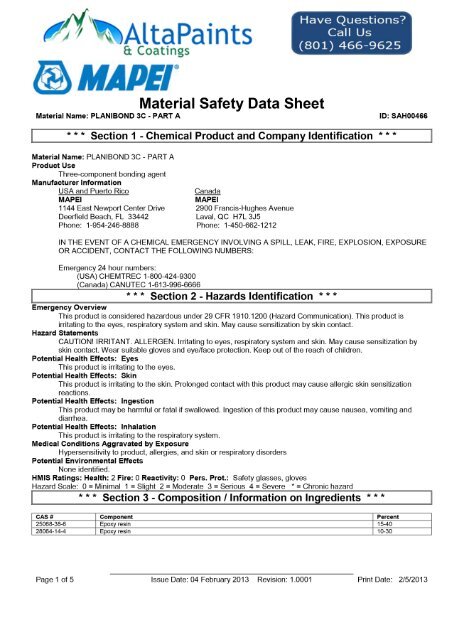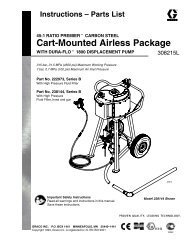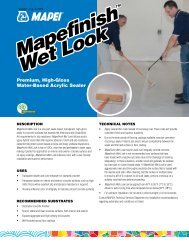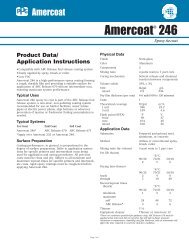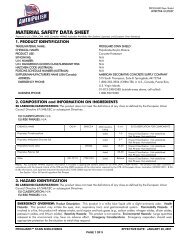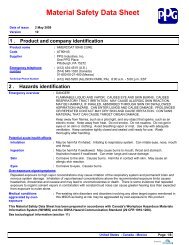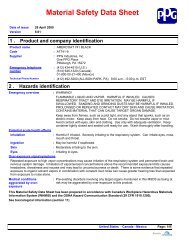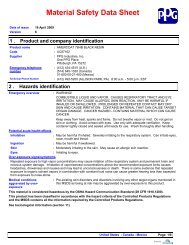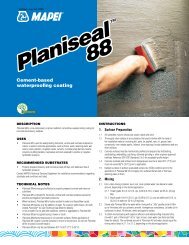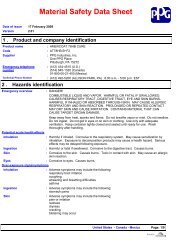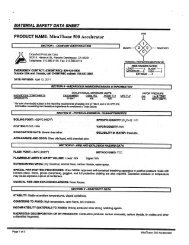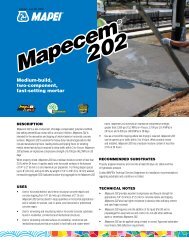Planibond 3C - MSDS
Planibond 3C - MSDS
Planibond 3C - MSDS
Create successful ePaper yourself
Turn your PDF publications into a flip-book with our unique Google optimized e-Paper software.
Material Safety Data SheetMaterial Name: PLANIBOND <strong>3C</strong> - PART AID: SAH00466* * * Section 4 - First Aid Measures * * *First Aid: EyesImmediately flush eyes with plenty of water for at least 15 minutes. If irritation persists, get medical attention.First Aid: SkinFlush with large amounts of water. If irritation persists, get medical attention.First Aid: IngestionFlush out mouth with water. If ingestion of a large amount does occur, seek medical attention. Do not inducevomiting.First Aid: InhalationImmediately remove the affected person to fresh air. If symptoms persist, get medical attention.First Aid: Notes to PhysicianProvide general supportive measures and treat symptomatically.* * * Section 5 - Fire Fighting Measures * * *General Fire HazardsSee Section 9 for Flammability Properties.This product is an aqueous mixture which will not burn. If evaporated to dryness, the solid residue may pose amoderate fire hazard.Hazardous Combustion ProductsIrritating and toxic gases or fumes may be released during a fire. Upon decomposition, this product emits carbonmonoxide, carbon dioxide and/or low molecular weight hydrocarbons.Extinguishing MediaDry chemical (preferred), foam, water.Fire Fighting Equipment/InstructionsFirefighters should wear full protective gear.NFPA Ratings: Health: 2 Fire: 0 Reactivity: 0Hazard Scale: 0 = Minimal 1 = Slight 2 = Moderate 3 = Serious 4 = Severe* * * Section 6 - Accidental Release Measures * * *Personal PrecautionsWear appropriate protective equipment and clothing during clean-up.Containment ProceduresDike the spilled material, where this is possible. Absorb with inert absorbent such as dry clay, sand ordiatomaceous earth, commercial sorbents, or recover using pumps. Scoop up used absorbent into drums or otherappropriate container.Environmental PrecautionsDispose of waste material according to Local, State, Federal, and Provincial Environmental Regulations.Clean-Up ProceduresAttempt to reclaim the free product, if this is possible. Shovel the material into waste container. Thoroughly washthe area with water after a spill or leak clean-up. Keep out of the reach of children.Evacuation ProceduresNone identified.Special ProceduresRegulations vary. Consult local authorities before disposal.* * * Section 7 - Handling and Storage * * *Handling ProceduresAvoid getting this material into contact with your skin and eyes. Wash hands after handling and before eating.Keep out of the reach of children.Storage ProceduresStore in a cool, dry, well-ventilated area. Store at ambient temperature and atmospheric pressure. Keep out ofsun.____________________________________________________________Page 2 of 5 Issue Date: 04 February 2013 Revision: 1.0001 Print Date: 2/5/2013
Material Safety Data SheetMaterial Name: PLANIBOND <strong>3C</strong> - PART AID: SAH00466* * * Section 8 - Exposure Controls / Personal Protection * * *A: Component Exposure LimitsACGIH, OSHA, NIOSH or the provinces of Canada have not developed exposure limits for any of this product'scomponents.Engineering ControlsProvide adequate local exhaust ventilation to maintain worker exposure below exposure limits. Local exhaust issuggested for use, where possible, in enclosed or confined spaces.PERSONAL PROTECTIVE EQUIPMENTPersonal Protective Equipment: Eyes/FaceWear safety glasses with side shields.Personal Protective Equipment: SkinThe use of nitrile-latex gloves is recommended.Personal Protective Equipment: RespiratoryNot normally needed. If airborne concentrations are above the applicable exposure limits, use NIOSH approvedrespiratory protection.Personal Protective Equipment: GeneralLaunder contaminated clothing before reuse. Use good industrial hygiene practices in handling this material.* * * Section 9 - Physical & Chemical Properties * * *Appearance: Liquid Odor: Epoxy odorPhysical State: Liquid pH: N/AVapor Pressure: N/A Vapor Density: N/ABoiling Point: N/A Melting Point: N/ASolubility (H2O): Insoluble Specific Gravity: 1.08Evaporation Rate: N/A VOC: 2 g/L (mixture)Octanol/H2O Coeff.: N/A Flash Point: N/AFlash Point Method: N/A Upper Flammability Limit (UFL): N/ALower Flammability Limit (LFL): N/A Burning Rate: N/AAuto Ignition: N/APhysical Properties: Additional InformationThe data provided in this section is to be used for product safety handling purposes. Please refer to Product DataSheets, Certificates of Conformity or Certificates of Analysis for chemical and physical data for determinations ofquality and for formulation purposes.* * * Section 10 - Chemical Stability & Reactivity Information * * *Chemical StabilityStable under normal conditions.Chemical Stability: Conditions to AvoidDo not freeze.IncompatibilityThis product may react with strong acids, bases and oxidizing agents.Hazardous DecompositionIrritating and/or toxic fumes and gases may be emitted upon the product's decomposition. Upon decomposition,this product may emit fumes of carbon monoxide, carbon dioxide, oxides of nitrogen, and other organiccompounds.Possibility of Hazardous ReactionsWill not occur.* * * Section 11 - Toxicological Information * * *Acute Dose EffectsA: General Product InformationNo information available for the product.____________________________________________________________Page 3 of 5 Issue Date: 04 February 2013 Revision: 1.0001 Print Date: 2/5/2013
Material Safety Data SheetMaterial Name: PLANIBOND <strong>3C</strong> - PART AID: SAH00466B: Component Analysis - LD50/LC50Epoxy resin (25068-38-6)Oral LD50 Rat 11400 mg/kgCarcinogenicityA: General Product InformationNo information available for the product.B: Component CarcinogenicityNone of this product's components are listed by ACGIH, IARC, OSHA, NIOSH, or NTP.SensitizationThis product may be sensitizing by prolonged skin contact.* * * Section 12 - Ecological Information * * *EcotoxicityA: General Product InformationNo information available for the product.B: Component Analysis - Ecotoxicity - Aquatic ToxicityNo ecotoxicity data are available for this product's components.* * * Section 13 - Disposal Considerations * * *US EPA Waste Number & DescriptionsA: General Product InformationNo additional information available.B: Component Waste NumbersNo EPA Waste Numbers are applicable for this product's components.Disposal InstructionsWaste must be handled in accordance with all federal, state, provincial, and local regulations. Consult authoritiesbefore disposal.See Section 7 for Handling Procedures. See Section 8 for Personal Protective Equipment recommendations.* * * Section 14 - Transportation Information * * *International Transportation RegulationsNot regulated as dangerous goods.* * * Section 15 - Regulatory Information * * *US Federal RegulationsA: General Product InformationAll components are on the U.S. EPA TSCA Inventory List. All components of this product are included, or areexempt from inclusion, in the Canadian Domestic Substance List unless otherwise noted.B: Component AnalysisNone of this products components are listed under SARA Section 302 (40 CFR 355 Appendix A), SARA Section313 (40 CFR 372.65), or CERCLA (40 CFR 302.4).State RegulationsA: General Product InformationOther state regulations may apply. Check individual state requirements.B: Component Analysis - StateNone of this product's components are listed on the state lists from CA, MA, MN, NJ, PA, or RI.The following statement(s) are provided under the California Safe Drinking Water and Toxic Enforcement Act of 1986 (Proposition 65):WARNING! This product contains a chemical known to the state of California to cause cancer.____________________________________________________________Page 4 of 5 Issue Date: 04 February 2013 Revision: 1.0001 Print Date: 2/5/2013
Material Safety Data SheetMaterial Name: PLANIBOND <strong>3C</strong> - PART AID: SAH00466Canadian WHMIS InformationA: General Product InformationB: Component Analysis - WHMIS IDLNo components are listed in the WHMIS IDL.WHMIS Classification: D2BAdditional Regulatory InformationA: General Product InformationSupplier(s) of proprietary component(s) state that these components are contained on the TSCA inventory.B: Component Analysis - InventoryComponent CAS # TSCA CAN EECEpoxy resin 25068-38-6 Yes DSL NoEpoxy resin 28064-14-4 Yes DSL No* * * Section 16 - Other Information * * *ReferenceT1-2521-51Other InformationReasonable care has been taken in the preparation of this information, but the manufacturer makes no warranty of merchantability or anyother warranty, expressed or implied, with respect to this information. The manufacturer makes no representations and assumes no liability forany direct, incidental or consequential damages resulting from its use. The information herein is presented in good faith and believed to beaccurate as of the effective date given. It is the buyer's responsibility to ensure that its activities comply with Federal, State or provincial, andlocal laws.<strong>MSDS</strong> History1.0000-1.0001This <strong>MSDS</strong> has been revised in the following section(s):Section 16 - Other InformationKey/LegendACGIH = American Conference of Governmental Industrial Hygienists; ADG = Australian Code for the Transport of Dangerous Goods byRoad and Rail; ADR/RID = European Agreement of Dangerous Goods by Road/Rail; AS = Standards Australia; BLV=Biological Limit Values;CAN = Canadian DSL and NDSL Inventories status; CAS = Chemical Abstracts Service; CC = Closed Cup; CFR = Code of FederalRegulations; DFG = Deutsche Forschungsgemeinschaft; DOT = Department of Transportation; DSL = Domestic Substances List; EEC =European Economic Community; EINECS = European Inventory of Existing Commercial Chemical Substances; ELINCS = European List ofNotified Chemical Substances; EPA = Environmental Protection Agency; EU = European Union; g/L = grams per Liter; HMIS = HazardousMaterials Identification System; IARC = International Agency for Research on Cancer; IMO = International Maritime Organization; IATA =International Air Transport Association; MAK = Maximum Concentration Value in the Workplace; mg/kg = milligrams per kilogram; mg/L =milligrams per Liter; mg/m3 = milligrams per Cubic Meter; NA, N/A, S.O. = Not available or Not Applicable; NDSL = Non-Domestic SubstancesList; NFPA = National Fire Protection Association; NIOSH = National Institute for Occupational Safety and Health; NJTSR = New JerseyTrade Secret Registry; NOHSC = National Occupational Health & Safety Commission; NTP = National Toxicology Program; OC = Open Cup;OSHA = Occupational Safety and Health Administration; STEL = Short-term Exposure Limit; TDG = Transportation of Dangerous Goods; TLV= Threshold Limit Value; TSCA = Toxic Substances Control Act; TWA = Time Weighted Average; TWAEV = Time Weighted AverageExposure Value; WHMIS = Workplace Hazardous Materials Information SystemContact: Product Safety SpecialistContact Phone: 1-954-246-8888End of Sheet SAH00466____________________________________________________________Page 5 of 5 Issue Date: 04 February 2013 Revision: 1.0001 Print Date: 2/5/2013
Material Safety Data SheetMaterial Name: PLANIBOND <strong>3C</strong> - PART BID: SAH00467* * * Section 1 - Chemical Product and Company Identification * * *Material Name: PLANIBOND <strong>3C</strong> - PART BProduct UseThree-component bonding agentManufacturer InformationUSA and Puerto RicoCanadaMAPEIMAPEI1144 East Newport Center Drive 2900 Francis-Hughes AvenueDeerfield Beach, FL 33442Laval, QC H7L 3J5Phone: 1-954-246-8888 Phone: 1-450-662-1212IN THE EVENT OF A CHEMICAL EMERGENCY INVOLVING A SPILL, LEAK, FIRE, EXPLOSION, EXPOSUREOR ACCIDENT, CONTACT THE FOLLOWING NUMBERS:Emergency 24 hour numbers:(USA) CHEMTREC 1-800-424-9300(Canada) CANUTEC 1-613-996-6666* * * Section 2 - Hazards Identification * * *Emergency OverviewThis product is considered hazardous under 29 CFR 1910.1200 (Hazard Communication). Causes burns to theskin and eyes. May cause sensitization by skin contact.Hazard StatementsDANGER! CORROSIVE. ALLERGEN. Causes burns to the skin and eyes. May cause sensitization by skincontact. Irritating to respiratory system. May be harmful or fatal if swallowed. Vapor harmful. Wear suitable gloves,eye/face protection, and respiratory protection. Keep out of the reach of children.Potential Health Effects: EyesThis product may be severely irritating to the eyes.Potential Health Effects: SkinThis product is severely irritating to the skin and may cause burns. Prolonged contact with this product may causeallergic skin sensitization reactions.Potential Health Effects: IngestionIngestion of this product may cause nausea, vomiting and diarrhea.Potential Health Effects: InhalationThis product is irritating to the respiratory system.Medical Conditions Aggravated by ExposureHypersensitivity to product, allergies, and skin or respiratory disordersPotential Environmental EffectsNone identified.HMIS Ratings: Health: 3 Fire: 0 Reactivity: 1 Pers. Prot.: Safety glasses, gloves, synthetic apron, vapor respiratorHazard Scale: 0 = Minimal 1 = Slight 2 = Moderate 3 = Serious 4 = Severe * = Chronic hazard* * * Section 3 - Composition / Information on Ingredients * * *CAS # Component PercentProprietary Aliphatic polyamine 10-3090530-15-7 2-Propenenitrile, reaction products with 3-amino-1,5,5-trimethylcyclohexanemethanamine 1-52855-13-2 Isophorone diamine 1-51477-55-0 m-Xylenediamine 1-5____________________________________________________________Page 1 of 6 Issue Date: 04 February 2013 Revision: 1.0001 Print Date: 2/5/2013
Material Safety Data SheetMaterial Name: PLANIBOND <strong>3C</strong> - PART BID: SAH00467* * * Section 4 - First Aid Measures * * *First Aid: EyesImmediately flush eyes with plenty of water for at least 15 minutes. Get medical attention or advice.First Aid: SkinWash immediately with soap and water. Get medical attention or advice.First Aid: IngestionFlush out mouth with water. Get medical attention or advice. Do not induce vomiting.First Aid: InhalationImmediately remove the affected person to fresh air. Get medical attention or advice.First Aid: Notes to PhysicianProvide general supportive measures and treat symptomatically.* * * Section 5 - Fire Fighting Measures * * *General Fire HazardsSee Section 9 for Flammability Properties.This product is an aqueous mixture which will not burn. If evaporated to dryness, the solid residue may pose amoderate fire hazard.Hazardous Combustion ProductsIrritating and toxic gases or fumes may be released during a fire. Upon decomposition, this product emits carbonmonoxide, carbon dioxide and/or low molecular weight hydrocarbons.Extinguishing MediaDry chemical (preferred), foam, water.Fire Fighting Equipment/InstructionsFirefighters should wear full protective clothing including self contained breathing apparatus.NFPA Ratings: Health: 3 Fire: 0 Reactivity: 1Hazard Scale: 0 = Minimal 1 = Slight 2 = Moderate 3 = Serious 4 = Severe* * * Section 6 - Accidental Release Measures * * *Personal PrecautionsWear appropriate protective equipment and clothing during clean-up.Containment ProceduresDike the spilled material, where this is possible. Absorb with inert absorbent such as dry clay, sand ordiatomaceous earth, commercial sorbents, or recover using pumps. Scoop up used absorbent into drums or otherappropriate container.Environmental PrecautionsDispose of waste material according to Local, State, Federal, and Provincial Environmental Regulations.Clean-Up ProceduresAttempt to reclaim the free product, if this is possible. Shovel the material into waste container. Thoroughly washthe area with water after a spill or leak clean-up. Keep out of the reach of children.Evacuation ProceduresNone identified.Special ProceduresRegulations vary. Consult local authorities before disposal.* * * Section 7 - Handling and Storage * * *Handling ProceduresAvoid getting this material into contact with your skin and eyes. Avoid breathing vapors or mists of this product.Wash hands after handling and before eating. Keep out of the reach of children.Storage ProceduresStore in a cool, dry, well-ventilated area. Store at ambient temperature and atmospheric pressure. Keep out ofsun.____________________________________________________________Page 2 of 6 Issue Date: 04 February 2013 Revision: 1.0001 Print Date: 2/5/2013
Material Safety Data SheetMaterial Name: PLANIBOND <strong>3C</strong> - PART BID: SAH00467* * * Section 8 - Exposure Controls / Personal Protection * * *A: Component Exposure Limitsm-Xylenediamine (1477-55-0)ACGIH: 0.1 mg/m3 CeilingSkin - potential significant contribution to overall exposure by the cutaneous routeOSHA: 0.1 mg/m3 CeilingPrevent or reduce skin absorptionNIOSH: 0.1 mg/m3 CeilingPotential for dermal absorptionAlberta: 0.1 mg/m3 CeilingSubstance may be readily absorbed through intact skinBritish Columbia: 0.1 mg/m3 CeilingSkin notationManitoba: 0.1 mg/m3 CeilingNew Brunswick: 0.1 mg/m3 CeilingSkin - potential for cutaneous absorptionNW Territories: 0.1 mg/m3 CeilingNova Scotia: 0.1 mg/m3 CeilingSkin - potential significant contribution to overall exposure by the cutaneous routeNunavut: 0.1 mg/m3 CeilingOntario: 0.1 mg/m3 CEVAbsorption through skin, eyes, or mucous membranesQuebec: 0.1 mg/m3 CeilingSkin designationSaskatchewan: 0.1 mg/m3 CeilingYukon: 0.1 mg/m3 CeilingEngineering ControlsProvide adequate local exhaust ventilation to maintain worker exposure below exposure limits. Local exhaust issuggested for use, where possible, in enclosed or confined spaces.PERSONAL PROTECTIVE EQUIPMENTPersonal Protective Equipment: Eyes/FaceWear safety glasses with side shields.Personal Protective Equipment: SkinThe use of nitrile-latex gloves is recommended.Personal Protective Equipment: RespiratoryNot normally needed. If airborne concentrations are above the applicable exposure limits, use NIOSH approvedrespiratory protection.Personal Protective Equipment: GeneralLaunder contaminated clothing before reuse. Use good industrial hygiene practices in handling this material.* * * Section 9 - Physical & Chemical Properties * * *Appearance: Liquid Odor: Epoxy odorPhysical State: Liquid pH: N/AVapor Pressure: N/A Vapor Density: N/ABoiling Point: N/A Melting Point: N/ASolubility (H2O): Insoluble Specific Gravity: 1.03Evaporation Rate: N/A VOC: 2 g/L (mixture)Octanol/H2O Coeff.: N/A Flash Point: N/AFlash Point Method: N/A Upper Flammability Limit (UFL): N/ALower Flammability Limit (LFL): N/A Burning Rate: N/AAuto Ignition: N/APhysical Properties: Additional InformationThe data provided in this section is to be used for product safety handling purposes. Please refer to Product DataSheets, Certificates of Conformity or Certificates of Analysis for chemical and physical data for determinations ofquality and for formulation purposes.____________________________________________________________Page 3 of 6 Issue Date: 04 February 2013 Revision: 1.0001 Print Date: 2/5/2013
Material Safety Data SheetMaterial Name: PLANIBOND <strong>3C</strong> - PART BID: SAH00467* * * Section 10 - Chemical Stability & Reactivity Information * * *Chemical StabilityStable under normal conditions.Chemical Stability: Conditions to AvoidDo not freeze.IncompatibilityThis product may react with strong acids, bases and oxidizing agents.Hazardous DecompositionIrritating and/or toxic fumes and gases may be emitted upon the product's decomposition. Upon decomposition,this product may emit fumes of carbon monoxide, carbon dioxide, oxides of nitrogen, and other organiccompounds.Possibility of Hazardous ReactionsWill not occur.* * * Section 11 - Toxicological Information * * *Acute Dose EffectsA: General Product InformationNo information available for the product.B: Component Analysis - LD50/LC50Isophorone diamine (2855-13-2)Oral LD50 Rat 1030 mg/kgm-Xylenediamine (1477-55-0)Inhalation LC50 Rat 700 ppm 1 h; Oral LD50 Rat 930 mg/kg; Dermal LD50 Rabbit 2000 mg/kgCarcinogenicityA: General Product InformationNo information available for the product.B: Component CarcinogenicityNone of this product's components are listed by ACGIH, IARC, OSHA, NIOSH, or NTP.SensitizationThis product may be sensitizing by prolonged skin contact.* * * Section 12 - Ecological Information * * *EcotoxicityA: General Product InformationNo information available for the product.B: Component Analysis - Ecotoxicity - Aquatic ToxicityIsophorone diamine (2855-13-2)Test & Species96 Hr LC50 Leuciscus idus 110 mg/L [semi-static]72 Hr EC50 Desmodesmus subspicatus 37 mg/L24 Hr EC50 Daphnia magna 42 mg/L48 Hr EC50 Daphnia magna 14.6 - 21.5 mg/L[semi-static]Conditions* * * Section 13 - Disposal Considerations * * *US EPA Waste Number & DescriptionsA: General Product InformationNo additional information available.B: Component Waste NumbersNo EPA Waste Numbers are applicable for this product's components.____________________________________________________________Page 4 of 6 Issue Date: 04 February 2013 Revision: 1.0001 Print Date: 2/5/2013
Material Safety Data SheetMaterial Name: PLANIBOND <strong>3C</strong> - PART BID: SAH00467Disposal InstructionsWaste must be handled in accordance with all federal, state, provincial, and local regulations. Consult authoritiesbefore disposal.See Section 7 for Handling Procedures. See Section 8 for Personal Protective Equipment recommendations.* * * Section 14 - Transportation Information * * *DOT InformationShipping Name: Amines, liquid, corrosive, n.o.s. (Aliphatic polyamine , Isophorone diamine , m-Xylenediamine)UN/NA #: UN2735 Hazard Class: 8 Packing Group: IIIShipping Name: Amines, liquid, corrosive, n.o.s. (Aliphatic polyamine , Isophorone diamine , m-Xylenediamine)UN #: UN2735 Hazard Class: 8 Packing Group: IIIIMDG InformationShipping Name: Amines, liquid, corrosive, n.o.s. (Aliphatic polyamine , Isophorone diamine , m-Xylenediamine)UN #: UN2735 Hazard Class: 8 Packing Group: IIITDG InformationShipping Name: Amines, liquid, corrosive, n.o.s. (Aliphatic polyamine , Isophorone diamine , m-Xylenediamine)UN/NA #: UN2735 Hazard Class: 8 Packing Group: III* * * Section 15 - Regulatory Information * * *US Federal RegulationsA: General Product InformationAll components are on the U.S. EPA TSCA Inventory List. All components of this product are included, or areexempt from inclusion, in the Canadian Domestic Substance List unless otherwise noted.B: Component AnalysisNone of this products components are listed under SARA Section 302 (40 CFR 355 Appendix A), SARA Section313 (40 CFR 372.65), or CERCLA (40 CFR 302.4).State RegulationsA: General Product InformationOther state regulations may apply. Check individual state requirements.B: Component Analysis - StateThe following components appear on one or more of the following state hazardous substances lists:Component CAS CA MA MN NJ PA RIIsophorone diamine 2855-13-2 No No No Yes No Nom-Xylenediamine 1477-55-0 Yes Yes Yes Yes Yes YesCanadian WHMIS InformationA: General Product Information____________________________________________________________Page 5 of 6 Issue Date: 04 February 2013 Revision: 1.0001 Print Date: 2/5/2013
Material Safety Data SheetMaterial Name: PLANIBOND <strong>3C</strong> - PART BID: SAH00467B: Component Analysis - WHMIS IDLThe following components are identified under the Canadian Hazardous Products Act Ingredient Disclosure List:Component CAS # Minimum ConcentrationIsophorone diamine 2855-13-2 1 %m-Xylenediamine 1477-55-0 1 %WHMIS Classification: D2B, EAdditional Regulatory InformationA: General Product InformationSupplier(s) of proprietary component(s) state that these components are contained on the TSCA inventory.B: Component Analysis - InventoryComponent CAS # TSCA CAN EEC2-Propenenitrile, reaction products with 3-amino-1,5,5- 90530-15-7 No No EINECStrimethylcyclohexanemethanamineIsophorone diamine 2855-13-2 Yes DSL EINECSm-Xylenediamine 1477-55-0 Yes DSL EINECS* * * Section 16 - Other Information * * *ReferenceT1-2522-51Other InformationReasonable care has been taken in the preparation of this information, but the manufacturer makes no warranty of merchantability or anyother warranty, expressed or implied, with respect to this information. The manufacturer makes no representations and assumes no liability forany direct, incidental or consequential damages resulting from its use. The information herein is presented in good faith and believed to beaccurate as of the effective date given. It is the buyer's responsibility to ensure that its activities comply with Federal, State or provincial, andlocal laws.<strong>MSDS</strong> History1.0000-1.0001This <strong>MSDS</strong> has been revised in the following section(s):Section 16 - Other InformationKey/LegendACGIH = American Conference of Governmental Industrial Hygienists; ADG = Australian Code for the Transport of Dangerous Goods byRoad and Rail; ADR/RID = European Agreement of Dangerous Goods by Road/Rail; AS = Standards Australia; BLV=Biological Limit Values;CAN = Canadian DSL and NDSL Inventories status; CAS = Chemical Abstracts Service; CC = Closed Cup; CFR = Code of FederalRegulations; DFG = Deutsche Forschungsgemeinschaft; DOT = Department of Transportation; DSL = Domestic Substances List; EEC =European Economic Community; EINECS = European Inventory of Existing Commercial Chemical Substances; ELINCS = European List ofNotified Chemical Substances; EPA = Environmental Protection Agency; EU = European Union; g/L = grams per Liter; HMIS = HazardousMaterials Identification System; IARC = International Agency for Research on Cancer; IMO = International Maritime Organization; IATA =International Air Transport Association; MAK = Maximum Concentration Value in the Workplace; mg/kg = milligrams per kilogram; mg/L =milligrams per Liter; mg/m3 = milligrams per Cubic Meter; NA, N/A, S.O. = Not available or Not Applicable; NDSL = Non-Domestic SubstancesList; NFPA = National Fire Protection Association; NIOSH = National Institute for Occupational Safety and Health; NJTSR = New JerseyTrade Secret Registry; NOHSC = National Occupational Health & Safety Commission; NTP = National Toxicology Program; OC = Open Cup;OSHA = Occupational Safety and Health Administration; STEL = Short-term Exposure Limit; TDG = Transportation of Dangerous Goods; TLV= Threshold Limit Value; TSCA = Toxic Substances Control Act; TWA = Time Weighted Average; TWAEV = Time Weighted AverageExposure Value; WHMIS = Workplace Hazardous Materials Information SystemContact: Product Safety RepresentativeContact Phone: 1-954-246-8888End of Sheet SAH00467____________________________________________________________Page 6 of 6 Issue Date: 04 February 2013 Revision: 1.0001 Print Date: 2/5/2013
Material Safety Data SheetMaterial Name: PLANIBOND <strong>3C</strong> - PART CID: SAH00468* * * Section 1 - Chemical Product and Company Identification * * *Material Name: PLANIBOND <strong>3C</strong> - PART CProduct UseThree-component bonding agentManufacturer InformationUSA and Puerto RicoCanadaMAPEIMAPEI1144 East Newport Center Drive 2900 Francis-Hughes AvenueDeerfield Beach, FL 33442Laval, QC H7L 3J5Phone: 1-954-246-8888 Phone: 1-450-662-1212IN THE EVENT OF A CHEMICAL EMERGENCY INVOLVING A SPILL, LEAK, FIRE, EXPLOSION, EXPOSUREOR ACCIDENT, CONTACT THE FOLLOWING NUMBERS:Emergency 24 hour numbers:(USA) CHEMTREC 1-800-424-9300(Canada) CANUTEC 1-613-996-6666* * * Section 2 - Hazards Identification * * *Emergency OverviewThis product is considered hazardous under 29 CFR 1910.1200 (Hazard Communication).White or gray powder. Cement odor. This product is irritating to the eyes and skin. Causes burns to the skin andeyes when mixed with water.Hazard StatementsDANGER! CORROSIVE. MAY IRRITATE EYES. MAY IRRITATE SKIN. Causes burns to the skin and eyes whenmixed with water. Chronic lung disease (silicosis) and/or lung cancer may result from prolonged/repeatedbreathing of the dust of this material. Wear suitable gloves, eye/face protection, and respiratory protection. Keepout of the reach of children.Potential Health Effects: EyesThis product is irritating to the eyes. Symptoms can include irritation, redness, scratching of the cornea, andtearing.Potential Health Effects: SkinThis product is irritating to the skin. Mechanical rubbing may increase skin irritation.Potential Health Effects: IngestionIngestion of this product may cause nausea, vomiting and diarrhea.Potential Health Effects: InhalationThis product is irritating to the respiratory system. Chronic lung disease (silicosis) and/or lung cancer may resultfrom prolonged/repeated breathing of the dust of this material. Inhalation of dusts produced during cutting,grinding or sanding of this product may cause irritation of the respiratory tract.Medical Conditions Aggravated by ExposureHypersensitivity to product, allergies, and skin or respiratory disordersPotential Environmental EffectsNone identified.HMIS Ratings: Health: 1* Fire: 0 Reactivity: 0 Pers. Prot.: Safety glasses, gloves, and N95 respirator if dust exposureexceeds TLV valuesHazard Scale: 0 = Minimal 1 = Slight 2 = Moderate 3 = Serious 4 = Severe * = Chronic hazard____________________________________________________________Page 1 of 7 Issue Date: 05 February 2013 Revision: 3.0000 Print Date: 2/5/2013
Material Safety Data SheetMaterial Name: PLANIBOND <strong>3C</strong> - PART CID: SAH00468* * * Section 3 - Composition / Information on Ingredients * * *CAS # Component Percent14808-60-7 Crystalline silica 40-7065997-15-1 Portland cement 15-4069012-64-2 Silicon dioxide 5-10532-32-1 Sodium benzoate 1-5* * * Section 4 - First Aid Measures * * *First Aid: EyesGet medical attention or advice. Immediately flush eyes with plenty of water for at least 15 minutes.First Aid: SkinGet medical attention or advice. Flush with large amounts of water.First Aid: IngestionGet medical attention or advice. Flush out mouth with water. Do not induce vomiting.First Aid: InhalationGet medical attention or advice. Immediately remove the affected person to fresh air.First Aid: Notes to PhysicianProvide general supportive measures and treat symptomatically.* * * Section 5 - Fire Fighting Measures * * *General Fire HazardsSee Section 9 for Flammability Properties.As with all dry powders, it is advisable to ground mechanical equipment in contact with dry material to dissipatethe potential buildup of static electricity.Hazardous Combustion ProductsIrritating and toxic gases or fumes may be released during a fire. Upon decomposition, this product emits carbonmonoxide, carbon dioxide and/or low molecular weight hydrocarbons.Extinguishing MediaDry chemical (preferred), foam, water.Unsuitable Extinguishing MediaNone identified.Specific Hazards Arising From the ChemicalNone identified.Fire Fighting Equipment/InstructionsFirefighters should wear full protective clothing including self contained breathing apparatus.NFPA Ratings: Health: 1 Fire: 0 Reactivity: 0Hazard Scale: 0 = Minimal 1 = Slight 2 = Moderate 3 = Serious 4 = Severe* * * Section 6 - Accidental Release Measures * * *Personal PrecautionsAvoid the generation of dust during clean-up. Wear appropriate protective equipment and clothing during cleanup.Containment ProceduresContain the discharged material.Environmental PrecautionsDispose of waste material according to Local, State, Federal, and Provincial Environmental Regulations.Clean-Up ProceduresAttempt to reclaim the free product, if this is possible. Shovel the material into waste container. Thoroughly washthe area with water after a spill or leak clean-up. Wear appropriate protective equipment and clothing duringclean-up. Keep out of the reach of children.____________________________________________________________Page 2 of 7 Issue Date: 05 February 2013 Revision: 3.0000 Print Date: 2/5/2013
Material Safety Data SheetMaterial Name: PLANIBOND <strong>3C</strong> - PART CID: SAH00468Evacuation ProceduresNone identified.Special ProceduresWear a dust mask if dust is generated above exposure limits.* * * Section 7 - Handling and Storage * * *Handling ProceduresDo not breathe dust from this material. Do not get this material in contact with skin or eyes. Wash hands afterhandling and before eating. Keep out of the reach of children.Storage ProceduresStore in a cool, dry, well-ventilated area. Keep the container tightly closed. Do not freeze.* * * Section 8 - Exposure Controls / Personal Protection * * *Exposure GuidelinesA: General Product InformationKeep formation of dusts, particulates and fumes to a minimum.B: Component Exposure LimitsCrystalline silica (14808-60-7)ACGIH: 0.025 mg/m3 TWA (respirable fraction)OSHA: 0.1 mg/m3 TWA (respirable dust)NIOSH: 0.05 mg/m3 TWA (respirable dust)Alberta: 0.025 mg/m3 TWA (respirable particulate)British Columbia: ACGIH Category A2 - Suspected Human Carcinogen; IARC Category 1 - Human Carcinogen0.025 mg/m3 TWA (respirable)Manitoba: 0.025 mg/m3 TWA (respirable fraction)New Brunswick: 0.1 mg/m3 TWA (respirable fraction)NW Territories: 0.1 mg/m3 TWA (respirable mass); 0.3 mg/m3 TWA (total mass)Nova Scotia: 0.025 mg/m3 TWA (respirable fraction)Nunavut: 0.1 mg/m3 TWA (respirable mass); 0.3 mg/m3 TWA (total mass)Ontario: 0.10 mg/m3 TWA (respirable fraction, listed under Silica, crystalline)0.10 mg/m3 TWA (designated substance regulation, respirable, listed under Silica, crystalline)Quebec: 0.1 mg/m3 TWAEV (respirable dust)Saskatchewan: 0.05 mg/m3 TWA (respirable fraction, listed under Silica - crystalline)Yukon: 300 particle/mL TWA (listed under Silica)Portland cement (65997-15-1)ACGIH: 1 mg/m3 TWA (particulate matter containing no asbestos and
Material Safety Data SheetMaterial Name: PLANIBOND <strong>3C</strong> - PART CID: SAH00468Silicon dioxide (69012-64-2)British Columbia: 4 mg/m3 TWA (total); 1.5 mg/m3 TWA (respirable)New Brunswick: 2 mg/m3 TWA (respirable fraction)Ontario: 2 mg/m3 TWA (respirable)Quebec: 2 mg/m3 TWAEV (containing no Asbestos and
Material Safety Data SheetMaterial Name: PLANIBOND <strong>3C</strong> - PART CID: SAH00468Oral LD50 Rat 500 mg/kgSodium benzoate (532-32-1)Oral LD50 Rat 2100 mg/kgCarcinogenicityA: General Product InformationExposure to quartz (the most stable and common form of crystalline silica) is responsible for the majority ofclinically diagnosed silicosis. Silicosis is a fibronodular lung disease that occurs after occupational exposure tocrystalline silica for 5 years or longer. Inhalation of quartz dusts may cause shortness of breath, limitation of chestexpansion, dry cough, and a lessened capacity for work. Individuals with a pre-existing disease in, or a history ofailments involving the skin or respiratory tract, are at a greater risk of developing adverse health effects whenexposed to this material. There may be a relationship between silicosis and certain cancers.B: Component CarcinogenicityCrystalline silica (14808-60-7)ACGIH: A2 - Suspected Human CarcinogenNIOSH: potential occupational carcinogenNTP:IARC:Known Human Carcinogen (respirable size) (Select Carcinogen)Monograph 100C [2012] (listed under Crystalline silica inhaled in the form of quartz or cristobalite fromoccupational sources); Monograph 68 [1997] (Group 1 (carcinogenic to humans))Portland cement (65997-15-1)ACGIH: A4 - Not Classifiable as a Human CarcinogenSensitizationNo information available for the product.* * * Section 12 - Ecological Information * * *EcotoxicityA: General Product InformationNo information available for the product.B: Component Analysis - Ecotoxicity - Aquatic ToxicitySodium benzoate (532-32-1)Test & Species96 Hr LC50 Pimephales promelas 420 - 558 mg/L [flowthrough]96 Hr LC50 Pimephales promelas >100 mg/L [static]48 Hr EC50 Daphnia magna
Material Safety Data SheetMaterial Name: PLANIBOND <strong>3C</strong> - PART CID: SAH00468* * * Section 15 - Regulatory Information * * *US Federal RegulationsA: General Product InformationAll of the components of this product are listed on, or are exempted from listing on the U.S. EPA TSCA Inventoryof Chemical Substances. All components of this product are included, or are exempt from inclusion, in theCanadian Domestic Substance List unless otherwise noted.B: Component AnalysisNone of this products components are listed under SARA Section 302 (40 CFR 355 Appendix A), SARA Section313 (40 CFR 372.65), or CERCLA (40 CFR 302.4).State RegulationsA: General Product InformationOther state regulations may apply. Check individual state requirements.B: Component Analysis - StateThe following components appear on one or more of the following state hazardous substances lists:Component CAS CA MA MN NJ PA RICrystalline silica 14808-60-7 No Yes Yes Yes Yes NoPortland cement 65997-15-1 No Yes Yes Yes Yes NoSilicon dioxide 69012-64-2 No No Yes No No NoThe following statement(s) are provided under the California Safe Drinking Water and Toxic Enforcement Act of 1986 (Proposition 65):WARNING! This product contains a chemical known to the state of California to cause cancer.Canadian WHMIS InformationA: General Product InformationD2A, EB: Component Analysis - WHMIS IDLThe following components are identified under the Canadian Hazardous Products Act Ingredient Disclosure List:Component CAS # Minimum ConcentrationCrystalline silica 14808-60-7 1 %Additional Regulatory InformationA: General Product InformationSupplier(s) of proprietary component(s) state that these components are contained on the TSCA inventory.B: Component Analysis - InventoryComponent CAS # TSCA CAN EECCrystalline silica 14808-60-7 Yes DSL EINECSPortland cement 65997-15-1 Yes DSL EINECSSilicon dioxide 69012-64-2 Yes DSL EINECSSodium benzoate 532-32-1 Yes DSL EINECS* * * Section 16 - Other Information * * *ReferenceI5-2426-02Other InformationDisclaimer: Reasonable care has been taken in the preparation of this information, but the manufacturer makes no warranty ofmerchantability or any other warranty, expressed or implied, with respect to this information. The manufacturer makes no representations andassumes no liability for any direct, incidental or consequential damages resulting from its use. The information herein is presented in goodfaith and believed to be accurate as of the effective date given. It is the buyer's responsibility to ensure that its activities comply with Federal,State or provincial, and local laws.____________________________________________________________Page 6 of 7 Issue Date: 05 February 2013 Revision: 3.0000 Print Date: 2/5/2013
Material Safety Data SheetMaterial Name: PLANIBOND <strong>3C</strong> - PART CID: SAH00468<strong>MSDS</strong> History2.0000-3.0000NOTE: THIS MATERIAL SAFETY DATA SHEET HAS UNDERGONE SIGNIFICANT CHANGES AND SHOULDBE READ IN ITS ENTIRETY.Key/LegendACGIH = American Conference of Governmental Industrial Hygienists; ADG = Australian Code for the Transport of Dangerous Goods byRoad and Rail; ADR/RID = European Agreement of Dangerous Goods by Road/Rail; AS = Standards Australia; BLV=Biological Limit Values;CAN = Canadian DSL and NDSL Inventories status; CAS = Chemical Abstracts Service; CC = Closed Cup; CFR = Code of FederalRegulations; DFG = Deutsche Forschungsgemeinschaft; DOT = Department of Transportation; DSL = Domestic Substances List; EEC =European Economic Community; EINECS = European Inventory of Existing Commercial Chemical Substances; ELINCS = European List ofNotified Chemical Substances; EPA = Environmental Protection Agency; EU = European Union; g/L = grams per Liter; HMIS = HazardousMaterials Identification System; IARC = International Agency for Research on Cancer; IMO = International Maritime Organization; IATA =International Air Transport Association; MAK = Maximum Concentration Value in the Workplace; mg/kg = milligrams per kilogram; mg/L =milligrams per Liter; mg/m3 = milligrams per Cubic Meter; NA, N/A, S.O. = Not available or Not Applicable; NDSL = Non-Domestic SubstancesList; NFPA = National Fire Protection Association; NIOSH = National Institute for Occupational Safety and Health; NJTSR = New JerseyTrade Secret Registry; NOHSC = National Occupational Health & Safety Commission; NTP = National Toxicology Program; OC = Open Cup;OSHA = Occupational Safety and Health Administration; STEL = Short-term Exposure Limit; TDG = Transportation of Dangerous Goods; TLV= Threshold Limit Value; TSCA = Toxic Substances Control Act; TWA = Time Weighted Average; TWAEV = Time Weighted AverageExposure Value; WHMIS = Workplace Hazardous Materials Information SystemContact: Product Safety RepresentativeContact Phone: 1-954-246-8888End of Sheet SAH00468____________________________________________________________Page 7 of 7 Issue Date: 05 February 2013 Revision: 3.0000 Print Date: 2/5/2013


